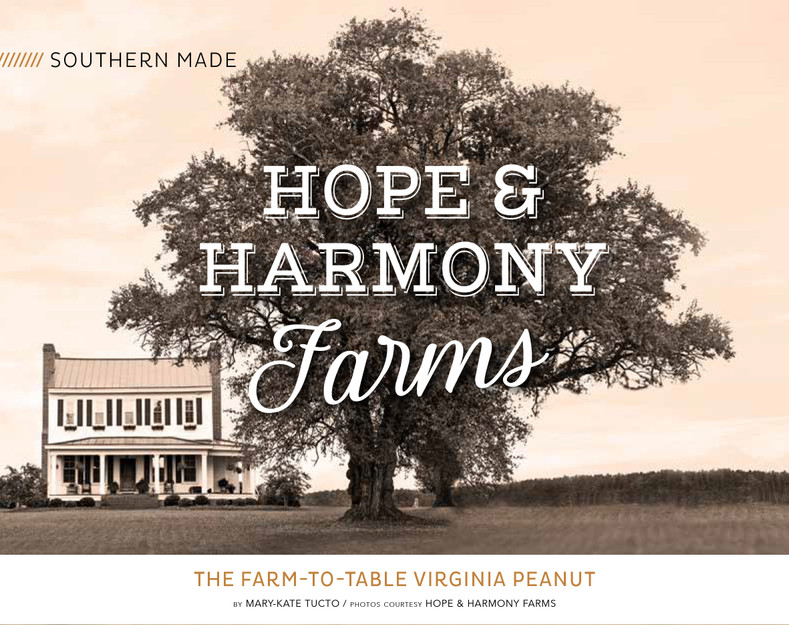The Farm-To-Table Virginia Peanut- Hope & Harmony Farms

Peanuts are small. Their crisp shells are easy to hold The kernels are blanched to remove the skins and sent in the palm of your hand. But for Hope & Harmony Farms, a fourth-generation family farm nestled in the town of Drewryville, Virginia, peanuts are a big deal.
“There are four types of peanuts, and the Virginia peanut is the largest of them all,” says Jeffrey Pope, one of three brothers who run the 5,000-acre* farm. Also known as the “ballpark peanut,” this variety is the kind you typically find a can of gourmet peanuts, thanks to its large kernel size and rich, buttery flavor. For generations, farming these peanuts has sustained the Pope family and their ancestors. “My grandfather and great grandfather farmed this land,” Jeffrey says. “So, after I went off to college at Virginia Tech and got a degree in agriculture, I came back.” Jeffrey’s two brothers, Chris and Mark, also felt the call of the family business.
“In 2001, we realized that just farming wasn’t going to support all three of our families,” Jeffrey explains. “That’s when we started the gourmet peanut business and began processing a lot of our own crop.” And as the business has grown, more family members have pitched in. Jeffrey’s wife, Stephanie, is head of marketing and oversees peanut cooking, Jeffrey and Chris tackle the majority of the farming operation, and Mark largely focuses on running the farm’s hunting business. Now, rather than simply selling the bulk of their crop to other companies to process and resell, the Popes are keeping a large portion of their peanuts to roast in-house and sell themselves, cutting out the middle man. “We’re a farm-to-table product,” Stephanie says. “Our motto is: ‘Love the land, respect your roots, and give your best.’”
This commitment to quality and hard work reaches every stage of life for each peanut at Hope & Harmony Farms, from planting to packaging. “We usually plant around early to mid- May,” Jeffrey says. “Then we start to harvest in mid- to late- September. And from the time we put the seed in the ground to when we harvest the crop, there’s a plethora of work to be done to feed and protect the plants.” Once the peanuts are harvested, Jeffrey and the team clean them up and send them in one of two directions. “If we’re wanting an in-shell product, the peanuts go into a machine that sizes them and grades them as jumbo or fancy,” he says. “If we’re looking for kernels, we send them through a shelling and sizing process. We use the super extra-large kernels of our Virginia peanuts in our gourmet products. They make up less than ten percent of any given crop, so they’re definitely a commodity.”
The kernels are blanched to remove the skins and sent over to the cooking facilities, where they are oil-roasted and seasoned. Packed with natural healthy fats and protein, and coated with flavors like Cajun Spice, Sea Salt & Black Pepper, and Butter Toffee, there’s a peanut for every palate. They even offer sweet peanut brittle, chewy peanut squares, and seasonally, cravable milk chocolate-coated peanuts. But for Jeffrey, nothing beats the original. “My favorite way to enjoy our peanuts happens once a year,” Jeffrey says. “We’ll go out in the field and, as we get the equipment ready to go, we’ll pull those peanuts right out of the ground and eat them as we’re walking along. There’s always some excitement and anticipation there because it’s been an entire year since we’ve been able to do it. To me, that’s just the best.” As a farm- to-table operation, that excitement, anticipation, and pure Virginia peanut flavor is what Hope & Harmony Farms strive to deliver in each product. “This is what we do on a daily basis,” Stephanie says. “We work really hard to keep all of our ingredients all natural so we can have a wholesome and delicious product. And we’re always working on something new. We’re very hopeful for the future—we hope to be sustainable and continue for generations to come.”
The above article was published in this month’s Taste of the SouthMagazine.
*Correction from original, which stated 1,300-acres
